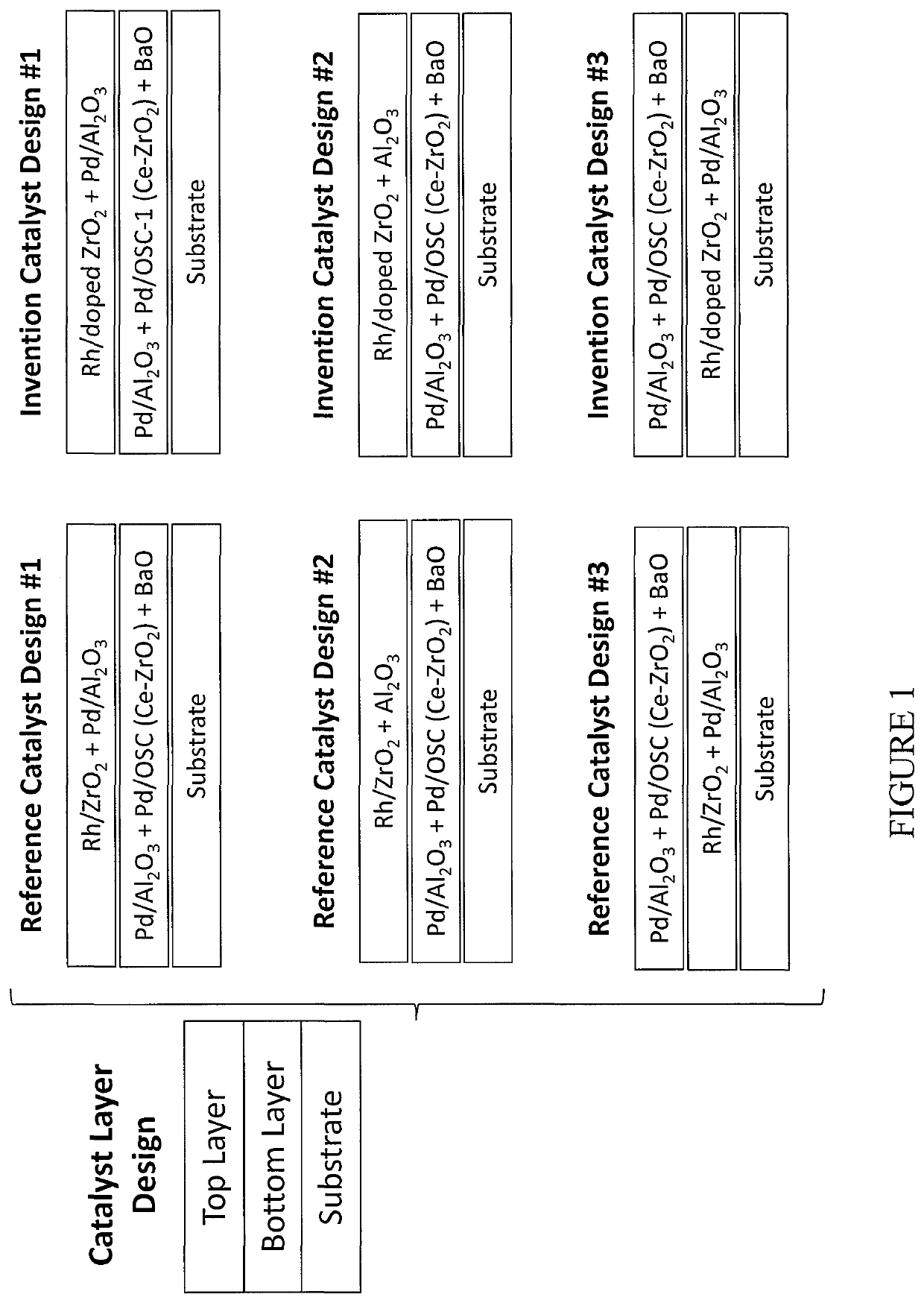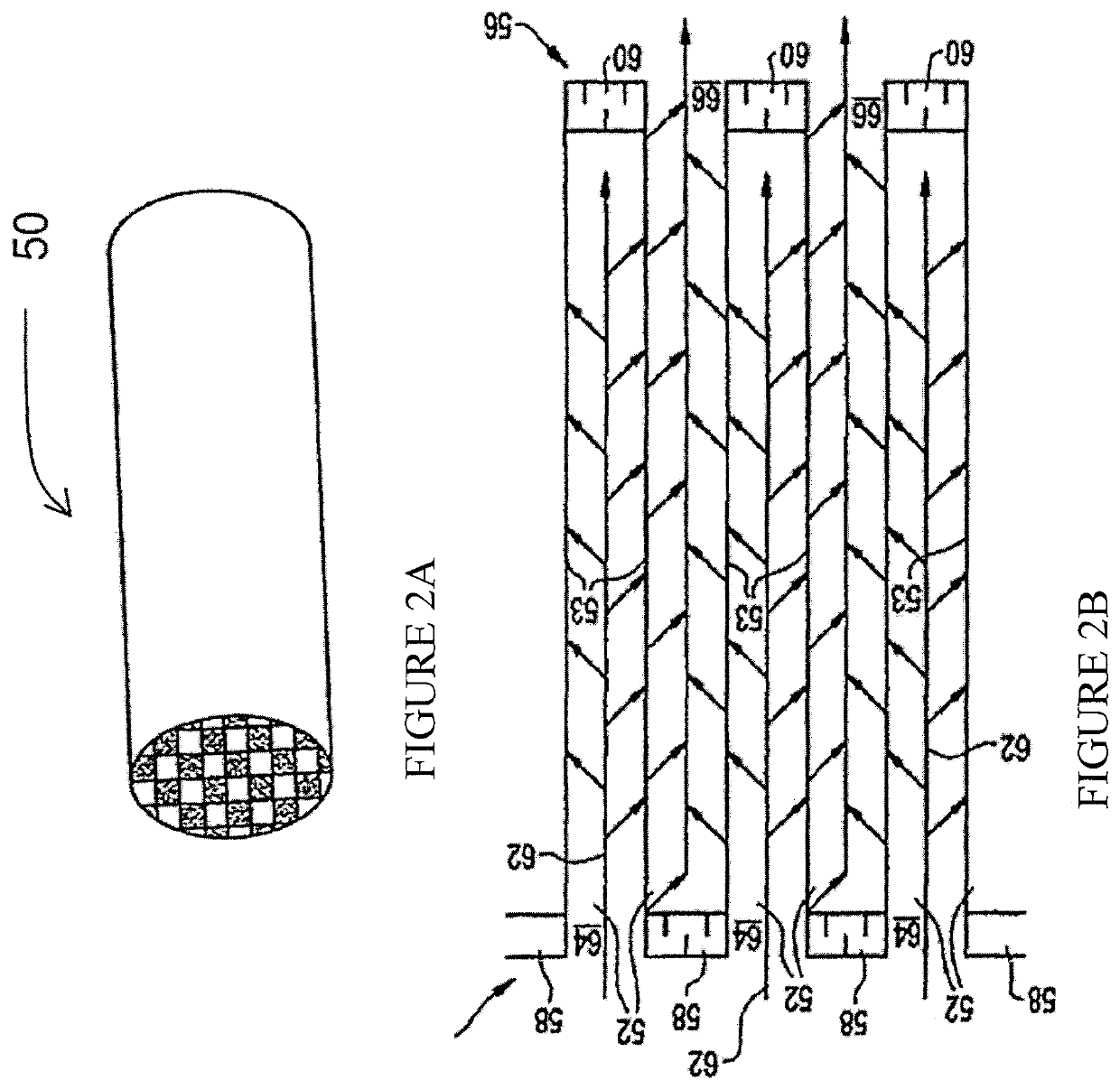Base metal doped zirconium oxide catalyst support materials
a zirconium oxide and catalyst technology, applied in metal/metal-oxide/metal-hydroxide catalysts, physical/chemical process catalysts, separation processes, etc., can solve the problems of increasing the number of catalyst components used to treat the exhaust gas of internal combustion engines, the operating temperature of catalyst components is generally too low for efficient treatment of engine exhaust gas, and the reduction of rhox species. , the effect of improving the reducibility of rhox species
- Summary
- Abstract
- Description
- Claims
- Application Information
AI Technical Summary
Benefits of technology
Problems solved by technology
Method used
Image
Examples
example 1
[0137]Powder catalysts according to the present disclosure were prepared, aged and tested.
[0138]Powder catalyst preparation: 1-15 wt. % La2O3, BaO, SrO, Al2O3, Nb2O5 were doped into ZrO2 materials either by incipient wetness impregnation method or co-precipitation method. The dopant precursors can be nitrates, acetates, chlorides, oxalates etc. After dopant impregnation or co-precipitation, the resulting ZrO2 materials were calcined at 550° C. for 2 h, and then Rh nitrate was impregnated onto these doped ZrO2 materials followed by calcination at 550° C. for 2 h again.
[0139]Aging and testing: The catalyst materials were subjected to 950 / 1050° C. under Lean-Rich condition with 10% steam for 5 h. A high throughput experimental reactor was used to measure light-off performance of HC, CO, NOx.
[0140]Powder catalyst testing results for 0.5 wt. % Rh supported on La2O3—ZrO2, BaO—ZrO2 and Al2O3—ZrO2 (at 10 wt. % dopant level) were measured. As shown in FIG. 10, comparing to the Rh / La2O3—ZrO2 ...
example 2
[0141]Powder catalysts with different ZrO2 dopants as Rh supports were compared. To better understand the promotion mechanism of BaO and Al2O3 dopants for ZrO2 as Rh supports, the powder catalysts after aging at 950° C. with 10% steam for 5 h were characterized using N2 physisorption, CO chemisorption and H2-Temperature-Programmed Reduction (TPR) methods.
[0142]As shown in Table 1 below, the BET surface area, pore volume and pore radius of Rh / BaO—ZrO2 and Rh / Al2O3—ZrO2 catalysts were all much smaller than those of Rh / La2O3—ZrO2 reference, suggesting that the sintering of the ZrO2 component was not inhibited by the BaO or Al2O3 dopants. It was further noted that the Rh / BaO—ZrO2 catalysts showed very low surface area and extremely small pore volume and pore radius, but still it showed much better light-off performance than Rh / La2O3—ZrO2 reference.
TABLE 1BET surface area, pore volume and pore radiusdetermined from N2 physisorption results (Sampleswere aged at 950° C. with 10% stm for 5 ...
example 3
[0145]Catalyst designs with Rh on different ZrO2 materials in top layers were compared. To see if the benefits of Rh / BaO—ZrO2 and Rh / Al2O3—ZrO2 observed in powder form can be successfully transferred to washcoated monolith catalysts, three washcoated catalysts on cordierite substrates were designed with a layered structure, i.e., having identical Pd bottom coats including Pd / La2O3—Al2O3, Pd / CeO2—ZrO2 and BaO, and different Pd+Rh top coats. In particular, as shown in FIG. 12, “Reference Catalyst” contains Rh / La2O3—ZrO2 in the top layer, while “Invention Catalyst #1” and “Invention Catalyst #2” contain Rh / BaO—ZrO2 and Rh / Al2O3—ZrO2 respectively in the top layers.
[0146]The different catalyst designs were tested on a Gasoline System Simulator (GSS). The as-prepared washcoated TWC catalysts (4.16″×1.5″, 600 / 4) were cored to 1.0″×1.5″ size, and then aged at 950° C. using Pulse Flame Reactor (PFR) at 950° C. for 12 h in full feed. Then, the cores were tested on GSS reactor using FTP-72 cyc...
PUM
| Property | Measurement | Unit |
|---|---|---|
| temperature | aaaaa | aaaaa |
| temperatures | aaaaa | aaaaa |
| weight percent | aaaaa | aaaaa |
Abstract
Description
Claims
Application Information
 Login to View More
Login to View More - R&D
- Intellectual Property
- Life Sciences
- Materials
- Tech Scout
- Unparalleled Data Quality
- Higher Quality Content
- 60% Fewer Hallucinations
Browse by: Latest US Patents, China's latest patents, Technical Efficacy Thesaurus, Application Domain, Technology Topic, Popular Technical Reports.
© 2025 PatSnap. All rights reserved.Legal|Privacy policy|Modern Slavery Act Transparency Statement|Sitemap|About US| Contact US: help@patsnap.com



